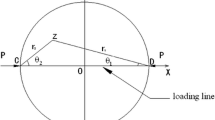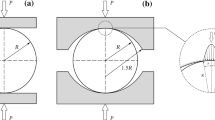Abstract
Tensile strength characterization of brittle materials by means of uniaxial tensile tests is often unfeasible, as most samples form chips during specimen preparation, leading to unacceptable geometric deviations. For this reason, the disc specimens used in Brazilian tests to determine indirect tensile strength are preferred. Despite its influence on the induced stress field and the location of the failure initiation point, the actual stress distribution along the contact is still under debate. In the present work, the complex variable method is used to develop a new analytical formulation based on the simplest possible shear stress distribution along the disc boundary that fulfils elastic equilibrium. Based on this formulation, an integration method is used to obtain the stress field generated inside specimens—elastic discs—that are subjected to distributed shear forces on their contact rims. An application of this method to the Brazilian test case is performed, proving that shear and frictional forces can be considered simultaneously. Furthermore, a mathematical procedure to simultaneously consider radial and shear stress distributions along the loaded boundary is developed to determine any possible stress field for relevant practical applications. The results confirm that shearing significantly increases stress in the vicinity of the contact area, which may explain the wedge failure pattern sometimes observed in real test specimens. Additionally, the proposed formulation guarantees that if failure is initiated in the centre of the specimen, the applied shear stress distribution no longer influences the indirect tensile strength of the material, although it influences the final test output if failure is initiated at any other point along the vertical diameter.







Similar content being viewed by others
Data Availability
No datasets were generated or analysed during the current study.
References
ISRM: Suggested methods for determining tensile strength of rock materials. Int. J. Rock Mech. Min. Sci. 15, 99–103 (1978)
ASTM D3967-16: Standard Test Method for Splitting Tensile Strength of Intact Rock Core Specimens (2016)
ASTM C496/C496M-17: Standard Test Method for Splitting Tensile Strength of Cylindrical Concrete Specimens (2017). https://doi.org/10.1520/C0496_C0496M-17
Fairbairn, E.M.R.: A tribute to Fernando L. L. B. Carneiro (1913 - 2001) engineer and scientist who invented the Brazilian test. Mater. Struct. 35, 195–196 (2002). https://doi.org/10.1617/13888
Timoshenko, S., Goodier, J.N.: Theory of Elasticity. McGraw-Hill, New York (1951)
Muskhelishvili, N.I.: Some Basic Problems of the Mathematical Theory of Elasticity. Noordhoff, Groningen (1953)
Yu, J., Shang, X.: Analysis of the in fl uence of boundary pressure and friction on determining fracture toughness of shale using cracked Brazilian disc test. Eng. Fract. Mech. 212, 57–69 (2019). https://doi.org/10.1016/j.engfracmech.2019.03.009
Kourkoulis, S.K., Markides, C.F., Chatzistergos, P.E.: The standardized Brazilian disc test as a contact problem. Int. J. Rock Mech. Min. Sci. 57, 132–141 (2013). https://doi.org/10.1016/j.ijrmms.2012.07.016
Kourkoulis, S.K., Markides, C.F., Hemsley, J.A.: Frictional stresses at the disc-jaw interface during the standardized execution of the Brazilian disc test. Acta Mech. 224, 255–268 (2013). https://doi.org/10.1007/s00707-012-0756-3
Guerrero-Miguel, D.J., Álvarez-Fernández, M.I., García-Fernández, C.C., González-Nicieza, C., Menéndez-Fernández, C.: Analytical and numerical stress field solutions in the Brazilian test subjected to radial load distributions and their stress effects at the centre of the disk. J. Eng. Math. 116, 29–48 (2019). https://doi.org/10.1007/s10665-019-10001-1
Alvarez-Fernandez, M.I., Garcia-Fernandez, C.C., Gonzalez-Nicieza, C., Guerrero-Miguel, D.J.: Effect of the contact angle in the failure pattern in slate under diametral compression. Rock Mech. Rock Eng. 53, 2123–2139 (2020). https://doi.org/10.1007/s00603-020-02044-z
Bahaaddini, M., Serati, M., Masoumi, H., Rahimi, E.: Numerical assessment of rupture mechanisms in Brazilian test of brittle materials. Int. J. Solids Struct. 180–181, 1–12 (2019). https://doi.org/10.1016/j.ijsolstr.2019.07.004
Kim, H.M., Lee, J.W., Yazdani, M., Tohidi, E., Nejati, H.R., Park, E.S.: Coupled viscous fluid flow and joint deformation analysis for grout injection in a rock joint. Rock Mech. Rock Eng. 51, 627–638 (2018). https://doi.org/10.1007/s00603-017-1339-3
Yuan, R., Shen, B.: Numerical modelling of the contact condition of a Brazilian disk test and its influence on the tensile strength of rock. Int. J. Rock Mech. Min. Sci. 93, 54–65 (2017). https://doi.org/10.1016/j.ijrmms.2017.01.010
Japaridze, L.: Stress-deformed state of cylindrical specimens during indirect tensile strength testing. J. Rock Mech. Geotech. Eng. 7, 509–518 (2015). https://doi.org/10.1016/j.jrmge.2015.06.006
Chau, K.T., Wei, X.X.: A three dimensional analytic solution for the Brazilian test. In: Frontiers of Rock Mechanics and Sustainable Development in the 21st Century, pp. 141–143 (2001)
Serati, M., Alehossein, H., Williams, D.J.: 3D elastic solutions for laterally loaded discs: generalised Brazilian and point load tests. Rock Mech. Rock Eng. 47, 1087–1101 (2014). https://doi.org/10.1007/s00603-013-0449-9.
Serati, M., Alehossein, H., Erarslan, N.: The Brazilian disc test under a non-uniform contact pressure along its thickness. Rock Mech. Rock Eng. 49, 1573–1577 (2016). https://doi.org/10.1007/s00603-015-0773-3
Wei, X.X., Chau, K.T.: Finite solid circular cylinders subjected to arbitrary surface load. Part I. Int. J. Solids Struct. 37, 5733–5744 (2000). https://doi.org/10.1016/S0020-7683(99)00290-5
Hondros, G.: The evaluation of Poisson’s ratio and the modulus of materials of a low tenisle resistance by the Brazilian (indirect tensile) test with particular reference to concrete. Aust. J. Basic Appl. Sci. 10, 243–268 (1959)
Markides, C.F., Pazis, D.N., Kourkoulis, S.K.: Closed full-field solutions for stresses and displacements in the Brazilian disk under distributed radial load. Int. J. Rock Mech. Min. Sci. 47, 227–237 (2010). https://doi.org/10.1016/j.ijrmms.2009.11.006
Hung, K.M., Ma, C.C.: Theoretical analysis and digital photoelastic measurement of circular disks subjected to partially distributed compressions. Exp. Mech. 43, 216–224 (2003). https://doi.org/10.1177/0014485103043002011
Ma, C.C., Hung, K.M.: Exact full-field analysis of strain and displacement for circular disks subjected to partially distributed compressions. Int. J. Mech. Sci. 50, 275–292 (2008). https://doi.org/10.1016/j.ijmecsci.2007.06.005
Addinall, E., Hackett, P.: Tensile failure in rock-like materials. In: Spokes, E.M., Christiansen, C.R. (eds.) The 6th U.S Symposium on Rock Mechanics (USRMS), pp. 515–538. American Rock Mechanics Association (1964)
Lavrov, A., Vervoort, A.: Theoretical treatment of tangential loading effects on the Brazilian test stress distribution. Int. J. Rock Mech. Min. Sci. 39, 275–283 (2002). https://doi.org/10.1016/S1365-1609(02)00010-2
Lanaro, F., Sato, T., Stephansson, O.: Microcrack modelling of Brazilian tensile tests with the boundary element method. Int. J. Rock Mech. Min. Sci. 46, 450–461 (2009). https://doi.org/10.1016/j.ijrmms.2008.11.007
Markides, C.F., Pazis, D.N., Kourkoulis, S.K.: Influence of friction on the stress field of the Brazilian tensile test. Rock Mech. Rock Eng. 44, 113–119 (2011). https://doi.org/10.1007/s00603-010-0115-4
Kourkoulis, S.K., Markides, C.F., Bakalis, G.: Elastic contact of smooth cylinders by caustics, pp. 25–27 (2013). https://doi.org/10.1007/s00419-012-0715-4
Markides, C.F., Kourkoulis, S.K.: The influence of jaw’s curvature on the results of the Brazilian disc test. J. Rock Mech. Geotech. Eng. 8, 127–146 (2016). https://doi.org/10.1016/j.jrmge.2015.09.008
Markides, C.F., Kourkoulis, S.K.: Naturally accepted boundary conditions for the Brazilian disc test and the corresponding stress field. Rock Mech. Rock Eng. 46, 959–980 (2013). https://doi.org/10.1007/s00603-012-0351-x
Kourkoulis, S., Markides, C.F., Chatzistergos, P.: A combined numerical and experimental study of the displacement field in the standardized Brazilian disc test. In: 10th HSTAM International Congress on Mechanics, pp. 1–8 (2013)
Lu, A., Wang, S., Cai, H.: Closed-form solution for the stresses in Brazilian disc tests under vertical uniform loads. Rock Mech. Rock Eng. 51, 3489–3503 (2018). https://doi.org/10.1007/s00603-018-1511-4
Sadd, M.H.: Elasticity. Elsevier, Amsterdam (2009)
Barber, J.R.: Elasticity. Springer, Netherlands (2010)
Sokolnikoff, I.S.: Mathematical Theory of Elasticity. McGraw-Hill, New York (1956)
Muskhelishvili, N.I.: Some Basic Problems of the Mathematical Theory of Elasticity. Noordhoff, Groningen (1953)
Kourkoulis, S.K., Markides, C.F., Hemsley, J.A.: Frictional stresses at the disc-jaw interface during the standardized execution of the Brazilian disc test. Acta Mech. 224, 255–268 (2013). https://doi.org/10.1007/s00707-012-0756-3
Markides, C.F., Kourkoulis, S.K.: Naturally accepted boundary conditions for the Brazilian disc test and the corresponding stress field. Rock Mech. Rock Eng. 46, 959–980 (2013). https://doi.org/10.1007/s00603-012-0351-x
Garcia-Fernandez, C.C., Gonzalez-Nicieza, C., Alvarez-Fernandez, M.I., Gutierrez-Moizant, R.A.: Analytical and experimental study of failure onset during a Brazilian test. Int. J. Rock Mech. Min. Sci. 103, 254–265 (2018). https://doi.org/10.1016/j.ijrmms.2018.01.045
Li, D., Li, B., Han, Z., Zhu, Q.: Evaluation on rock tensile failure of the Brazilian discs under different loading configurations by digital image correlation. Appl. Sci. 10, 5513 (2020). https://doi.org/10.3390/app10165513
Acknowledgements
This research was funded by the Ministry of Science and Innovation of Spain through Grant MCINN-23-PID2022-142015OB-I00 funded by MCIN/AEI/10.13039/501100011033 and by “ERDF A way of making Europe” and by the Regional Foundation for Scientific and Technological Research FICYT through grant SV-PA-21-AYUD/2021/51328.
Author information
Authors and Affiliations
Contributions
Mathematical development and coding, D.-J.G.-M. and C.G.-N.; visualization, D.-J.G.-M.; writing—original draft preparation, M.-B.P.-G.; writing—review and editing, M.-I.Á.-F.; supervision, C.G.-N.. All authors have read and agreed to the published version of the manuscript.
Corresponding author
Ethics declarations
Competing Interests
The authors declare that there is no conflict of interest between the exposed results and the funding detailed in the acknowledgements section.
Additional information
Publisher’s Note
Springer Nature remains neutral with regard to jurisdictional claims in published maps and institutional affiliations.
Rights and permissions
Springer Nature or its licensor (e.g. a society or other partner) holds exclusive rights to this article under a publishing agreement with the author(s) or other rightsholder(s); author self-archiving of the accepted manuscript version of this article is solely governed by the terms of such publishing agreement and applicable law.
About this article
Cite this article
Guerrero-Miguel, DJ., Prendes-Gero, MB., Álvarez-Fernández, MI. et al. Induced Stress Fields in Isotropic Elastic Discs Due to Contact Shear Stresses and Their Implications for Brazilian Test Strength Characterization. J Elast (2024). https://doi.org/10.1007/s10659-024-10072-x
Received:
Accepted:
Published:
DOI: https://doi.org/10.1007/s10659-024-10072-x




